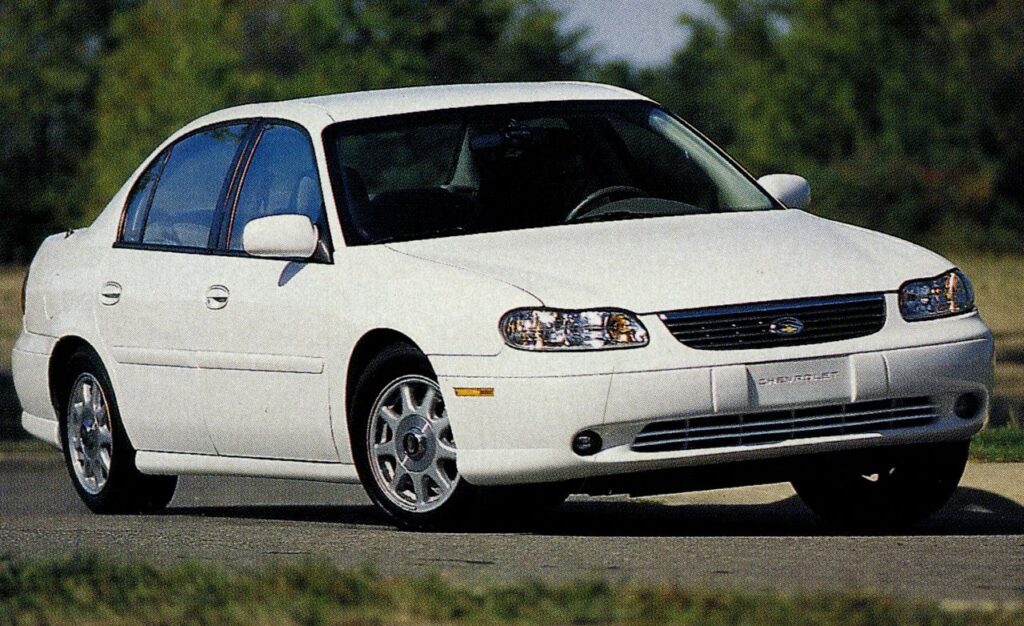Table of Contents
ToggleThe 1997 Chevrolet Malibu marked a significant shift from the classic muscle car era to a more modern, practical approach. As part of the sixth generation (1997-2003), this Malibu was designed to compete with popular midsize sedans like the Toyota Camry and Honda Accord.
While it didn’t have the V8 power of its 1970s predecessor, the ’97 Malibu offered reliability, comfort, and affordability—making it a favorite among families and daily commuters.
In this article, we’ll explore:
The history and development of the 1997 Malibu
Engine options and fuel efficiency
Interior features and comfort
Common problems and reliability
Why it’s still a great used car today
Buying tips for a used 1997 Malibu
Whether you’re looking for a cheap used car or just nostalgic for ‘90s sedans, this guide will cover everything you need to know about the 1997 Chevrolet Malibu.

History of the 1997 Chevrolet Malibu
After the Malibu nameplate took a break in the 1980s, Chevrolet revived it in 1997 as a replacement for the Chevy Corsica. Unlike the classic rear-wheel-drive Malibus of the ‘60s and ‘70s, the 1997 model was a front-wheel-drive, family-focused sedan.
Key Features of the 1997 Malibu:
Built on the GM N-platform (shared with the Pontiac Grand Am and Oldsmobile Cutlass)
Available in LS and base trim levels
Competed with the Ford Taurus, Honda Accord, and Toyota Camry
Emphasized fuel efficiency and practicality over performance
1997 Chevrolet Malibu Engine & Performance
The 1997 Malibu wasn’t a speed demon, but it provided solid, dependable performance for everyday driving.
Engine Options:
2.4L TwinCam (LD9) Inline-4 – The standard engine, producing 150 horsepower and 155 lb-ft of torque.
Fuel Economy: ~20 MPG city / 30 MPG highway
Paired with a 4-speed automatic transmission
3.1L (L82) V6 – Optional in the Malibu LS, making 155 horsepower and 185 lb-ft of torque.
Fuel Economy: ~18 MPG city / 27 MPG highway
Smoother acceleration than the 4-cylinder
Performance Specs:
0-60 MPH: ~9-10 seconds (V6) / ~10-11 seconds (4-cylinder)
Top Speed: ~115-120 MPH (electronically limited)
Front-Wheel Drive – Good for fuel efficiency but not for sporty driving
Handling & Ride Comfort:
Soft suspension tuning – Focused on comfort rather than sharp handling
Quiet cabin – Better noise insulation than many competitors
Decent trunk space (15.2 cu ft) – Great for family trips
Interior Features & Comfort
The 1997 Malibu was designed to be a practical, no-nonsense family car. While it didn’t have luxury-level features, it offered good value for the price.
Standard Features (Base Model):
Cloth seats (bench or bucket options)
AM/FM radio (optional CD player)
Power steering & brakes
Manual windows & locks (power options available in higher trims)
Upgrades in the Malibu LS:
Power windows & locks
Cruise control
Air conditioning (standard in LS, optional in base)
Upgraded stereo system
Leather-wrapped steering wheel
Seating & Space:
Comfortable for five passengers (though rear legroom was tight for taller adults)
Decent visibility – Large windows and thin pillars
Simple, functional dashboard – Easy-to-use controls
Reliability & Common Problems
The 1997 Malibu was generally reliable, but like any older car, it had some common issues.
Common Problems to Watch For:
Intake Manifold Gasket Failure (especially in the 3.1L V6) – Could lead to coolant leaks.
Transmission Issues – Some models had 4T40-E/4T45-E transmission failures around 100,000+ miles.
Rust on Rocker Panels & Wheel Wells – A common issue in older GM cars.
Electrical Gremlins – Power window switches and sensors could fail over time.
Why It’s Still a Good Used Car Today:
Cheap to buy – Often found for $1,500-$4,000 in decent condition.
Easy to repair – Parts are inexpensive and widely available.
Good fuel economy – Still competitive with modern economy cars.
1997 Malibu vs. Competitors
| Feature | 1997 Chevy Malibu | 1997 Honda Accord | 1997 Toyota Camry | 1997 Ford Taurus |
|---|---|---|---|---|
| Base Engine | 2.4L I4 (150 HP) | 2.2L I4 (130 HP) | 2.2L I4 (133 HP) | 3.0L V6 (145 HP) |
| Top Engine | 3.1L V6 (155 HP) | 2.7L V6 (170 HP) | 3.0L V6 (194 HP) | 3.4L V6 (200 HP) |
| MPG (City/Hwy) | 20/30 (I4) | 23/30 (I4) | 22/30 (I4) | 19/26 (V6) |
| Reliability | Good | Excellent | Excellent | Average |
| Price (Used Today) | $1,500-$4,000 | $3,000-$6,000 | $3,500-$7,000 | $2,000-$5,000 |
Verdict: The Malibu was a budget-friendly alternative to the Accord and Camry but didn’t last as long. However, it’s much cheaper to buy today and still a decent choice for a beater car.
Buying a Used 1997 Malibu: What to Check
If you’re considering a 1997 Malibu, inspect these key areas:
1. Engine & Transmission
Check for coolant leaks (common with the 3.1L V6).
Test the transmission for slipping or hard shifts.
2. Rust & Body Condition
Look under the car for rotted rocker panels or frame rust.
3. Electrical Systems
Test all power windows, locks, and dashboard lights.
4. Maintenance Records
A well-maintained Malibu can easily reach 200,000+ miles.
Final Thoughts: Is the 1997 Malibu Worth It Today?
The 1997 Chevrolet Malibu was never a flashy car, but it was affordable, practical, and reliable—qualities that still make it a decent used car today.
Who Should Buy One?
First-time car buyers looking for a cheap, easy-to-fix sedan.
Classic ‘90s car enthusiasts who appreciate simple, no-frills vehicles.
DIY mechanics – Great for learning basic repairs.
Who Should Avoid It?
Those wanting modern safety features (no airbags in some models).
People needing long-distance reliability (better options exist).
FAQ About the 1997 Chevrolet Malibu
Q: How many miles can a 1997 Malibu last?
Q: Is the 4-cylinder or V6 better?
Q: Are parts still available?
Conclusion
The 1997 Chevrolet Malibu won’t win any races, but it’s a solid, no-nonsense sedan that’s perfect for budget buyers. If you find one in good shape, it can still be a reliable daily driver—or even a fun throwback ‘90s car.
Would you drive a 1997 Malibu today? Let us know in the comments!

